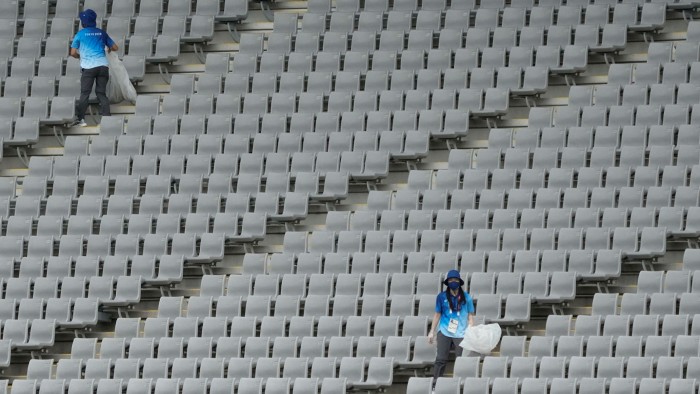Empty Olympic stadiums offer psychologists a rare opportunity


Roula Khalaf, Editor of the FT, selects her favourite stories in this weekly newsletter.
There was a moment last Monday night during a close-fought Olympic handball heat when a lonely-looking volunteer near the fire exit dropped her clipboard. The clatter was, by some margin, the most audible thing in the Yoyogi National Gymnasium.
An instant later, the clipboard’s brief sonic reign was ended by the squeak of non-marking soles, the low bark of an exasperated coach, the ball slapping from one resin-caked palm to another. These were all the usual sounds of intense handball competition, but ludicrously amplified by the absence of a live audience and the acoustics of Kenzo Tange’s architectural masterpiece.
However these Games are ultimately remembered, sports psychologists have a truly unique case study on their hands, something that may come close to a control experiment in the way that live audiences affect athletes, the ferocity of competition and the resonance of everything for those watching on TV.
Clearly, the Olympics are not alone in this. For almost 18 months, the sports world has adapted with various makeshift measures to lockdowns and other anti-Covid restrictions. Cardboard audiences, roaring crowd sound effects and other wheezes have been drafted in to fill the gap.
The big difference, explained athletes and coaches interviewed by the Financial Times over the Games’ first week, is that Olympics audiences have always been unique in their scale, passion and diversity. The organisers have not dared attempt to replicate or substitute this force artificially, leaving teams to wrestle with the effect and to test, on the grandest stage, the theory that audiences have a measurable impact on performance.
The first full week of the Tokyo 2020 Games has produced many versions of the Yoyogi gymnasium phenomenon across the different facilities and disciplines — the sploshes, thuds, thwacks, muttered conversations and other aural minutiae of international sport at its highest level echoing unloved and unanswered around seats and stands.
Japanese organisers made the decision to hold the event without live audiences — the first modern Olympics to do so — at the last possible minute. The now rapidly rising Covid-19 infection figures in Tokyo have dulled much of the initial objection to that call. But the athletes have yet to provide a definitive answer on whether or not the crowdlessness is a good thing. Records have, as at all Olympics, been broken but the general observation has been that something visceral, even gladiatorial, has been stripped from proceedings. Among male and female beach volleyball players, where the emptiness of the arena has given cicadas a starring role in the soundtrack, the division of opinion is striking. Ágatha Bednarczuk, a Brazilian medallist in 2016, emerged from winning a match last week saying that the silence had helped her to focus.
The US men’s team described the same environment as an atmospheric void that made it hard to compete. “We were playing real tentative, there was no energy, it was kind of flat”, said Nick Lucena, before his teammate Phil Dalhausser added that “this whole Olympics has been kind of a bummer”.
Some athletes — especially those who trained with fake crowd noises by way of preparation before discovering that spectators would be banned — are citing the silence as a meaningful source of stress.
In some venues there is just eerie silence. In others, coaches and accredited support staff attempt to fill the void with echoey (and often quite annoying) applause, while in others still the organisers continue to blast high-energy music between matches to work up non-existent crowds. At the boxing, a delegation from Uzbekistan managed to get a drum past security and into the gallery of the Kokugikan stadium, to a pleasingly raucous — and almost normalising — effect. Now that the track and field events are under way, questions regarding the impact of all this will be answered by the vacant seats of the largest and most crowdless venue Tokyo has on offer.
If we are, in fact, watching a giant unintended experiment, the most significant revelation may be a reappraisal of the practical meaning of home advantage. Japan, after an extraordinary first week deluge of gold medals, now sits just below the US and only relinquished its top spot in the table to China on Friday. It has done so with the same very tiny representations in the stands as other countries, and in many cases those delegations have been much quieter than other contingents. “Maybe because these are Japanese venues, it is easier for the athletes to imagine them filled with home supporters,” shrugged one member of the Japanese table tennis coaching team.
To keep up to date with the latest Olympic developments, click the button “Add to myFT” at the top of this page
Comments